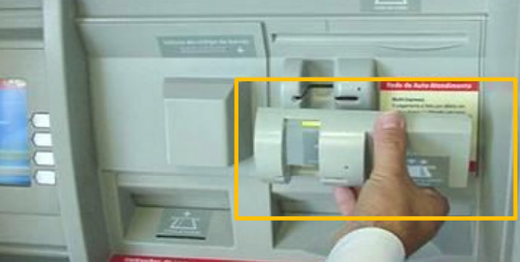Do not fall prey to ATM card skimming scams. A card skimmer is an illegal device that criminals attach to card readers at ATMs. Scammers can quickly read a card’s information and use it to access your account fraudulently. With a small device, your card’s information gets stored so that criminals can easily use it at a later time.
Skimmers may be installed on ATM machines, resembling the machine itself. A small device goes over the normal card reading slot and reads your card’s magnetic stripe. Skimmers can also be handheld devices that a dishonest merchant can keep in his or her pocket. When charging your card while you are out at dinner, for example, a scammer can run your card through a skimmer as well.
Recognizing Card Skimming Devices, Pinhole Cameras, and Fake Keypads:
- Card-reader overlays: The most common ATM skimmer, and perhaps the easiest device to detect, is the card-reader overlay. It is made of plastic and fits over the slot where you insert your card. As you insert your card, the device reads the data from your card and stores it.
- Hidden cameras: Thieves sometimes hide tiny cameras on or around ATMs. If positioned correctly, a brochure holder on an ATM is the perfect place to hide a mini- camera that can record PIN numbers as customers type them in.
- PIN-capture overlays: Criminals have been known to attach dummy keypads over an ATM's real keypad to record and capture PIN numbers as they are. The keypad might be fake if it looks too thick or different from what you're used to seeing.
- Fake ATM faceplates: Some thieves go as far as placing a fake ATM cover that could contain card-reader overlays, hidden cameras and PIN-capture overlays over some or all of a real, fully operating ATM. The best way to determine if an ATM has a false cover is to look for flaws like loose wires, seams that are not flush and slots or keypads that look out of place.
How to Avoid Card Skimming:
- Use the safest payment method available. Tapping your digital wallet or a contactless card can be safer than inserting or swiping your card. If that's not an option, inserting the card's chip is safer than swiping.
- Cover the pad when typing in your PIN. It's not a fool-proof method because a keypad overlay could still record what you type, but covering your hand when you enter your PIN or ZIP code can keep cameras from recording what you type.
- Compare nearby card readers. Even minor differences, such as odd colors or small holes, could indicate the presence of a card skimming device.
- Manipulate the edge of the device. You could try pulling on the card reader or keypad to see if there's a skimming device that moves or comes off.

If you see an attachment like the ones described above, do not use the ATM and report it immediately to the branch where the ATM is located.
What to do if your credit or debit card has been skimmed:
If you believe you have been a victim of an ATM Skimmer, please contact the number on the back of your card.
Need help?
Contact Us
Call us at 1-855-325-2226
Mon-Fri: 5:30 am - 6:00 pm (PST)
Sat: 6:00 am - 1:00 pm (PST)
Message Us
Send us an email and one of our
representatives will reach out to
you soon.


